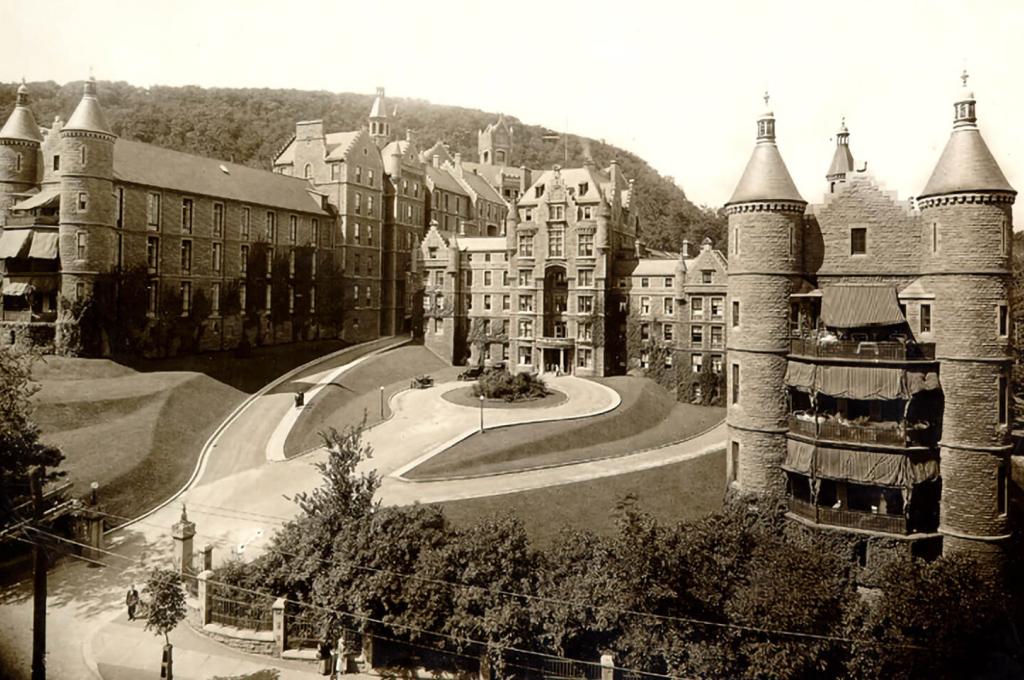In the basement of Montréal’s Royal Victoria Hospital (RVH), researchers at McGill University uncovered a 130-year-old ventilation system that includes an early example of heat recovery. The design holds the promise of reducing the costs and emissions of heating modern-day homes and buildings.
In the late 19th century, interior airflow depended entirely on the natural buoyancy of hot air: as warm air rose through chimneys or out of vents on the upper floors, cool, fresh air was dragged in behind it. These passive systems could be surprisingly complex, relying on the deliberate placement of windows, doors, vents and chimneys to maximize the movement of air.
The RVH system, for example, included a seven-storey chimney connected to a furnace in the basement which heated the air, forcing it to rise, thus circulating air through the hospital wards and the rest of the building.
“If you think about the motive power of 100-degree-Celsius air rising 100 feet through a chimney, it’s actually quite powerful,” says Anna Halepaska, a PhD student in architecture at McGill, who is part of the research team investigating the RVH system. “It works like a fan and would pull everything behind it. It’s sort of a precursor to the mechanical systems we’re familiar with, but it’s all heat-driven.”
Ventilation a preoccupation in an era obsessed with bad air
It was a common design in public institutions in an era that was “absolutely terrified of the idea of bad air, especially in a hospital,” says Halepaska. But the RVH design includes something uncommon: a system of flues that brought the heated air back to the basement.
“We have this beautiful set of drawings from the 1890s showing this embedded loop of ducts that are built into the walls of the hospital,” says Halepaska. “We uncovered that system and became very curious about why they were making this loop back down to the basement. Why would you pull air against the way it wants to rise? As far as we can tell, they were using it as heat recovery from the hot exhaust air to the cold intake air. In the 1890s! Which is exciting!”
Halepaska’s excitement is warranted — if otherwise wasted heat can be recovered in a passive system, requiring no additional input of energy, it could have important applications in new buildings.
Passive heat exchange went out of fashion in the early 20th century with the advent of electricity. Modern HVAC systems used electric fans to force heated or cooled air through a network of ducts. These energy-intensive systems had the advantage of keeping inside spaces at perfectly comfortable temperatures, regardless of the climate or season. Until the oil crisis of the 1970s, there was little concern for the energy expended to create those conditions.
But today, reducing our energy consumption is front-of-mind under the spectre of climate change, and the passive heating and cooling systems of yesteryear have taken on new allure.
“Looking for alternatives to mechanical heating and cooling is crucial,” says Salmaan Craig, who is Halepaska’s supervisor, Assistant Professor at the Peter Guo-hua Fu School of Architecture at McGill, and one of the researchers who first uncovered the RVH design. “These systems are set to cause more and more emissions — from their use, manufacture and leaking refrigerants — in a warming world.”
The discovery of the RVH system builds on an exploration of the hospital as an important part of Montréal’s architectural history. Annmarie Adams, an architectural historian at McGill, has researched the history of the RVH, from the perspective of hospital design, medical history and the experience of nurses. An article she wrote describing the ventilation system at the hospital ignited Craig’s curiosity. In 2020 and 2021, he then conducted studies to prove that a heat recovery system was in fact present and to begin to understand how it worked. “Anna became fully involved with the RVH study as we realized this was an important discovery and needed fuller historical and experimental attention,” says Craig.
An old-school ventilation scheme makes a resurgence
“There’s a resurgence of interest in natural ventilation and passive design techniques, but it has been 100 years since we’ve tried to ventilate buildings in this way on any large scale,” says Halepaska. “We’ve forgotten a lot of that.”
So, to figure out how a passive heat recovery system could make its comeback, Halepaska is using CFI-funded equipment to model the airflow inside the original RVH. She does this by setting up analogue models on an anti-vibration table that is fitted with lights, cameras and backgrounds to film how the heat and air flows through the models. A suite of sensors measures air temperature, air velocity and the transfer of heat between spaces.
The goal is to “demystify” the system by establishing a set of mathematical parameters for the placement of vents and other elements, which should then provide architectural designers a template for how to efficiently incorporate the design principles behind the RVH into new buildings. Her work is supported by a Vanier Canada Graduate Scholarship.
All of the equipment Halepaska is using will become part of a larger, soon-to-be-operational CFI-funded facility at McGill called the Building Architectural Research Node. There, Craig’s research team will develop alternative approaches for passive cooling, heating and ventilation, as well as construction methods for buildings that are both adaptable to changing climates and also serve as carbon sinks.
Looking to the past for ventilation designs of the future
To get a fuller picture of how the bygone RVH system came about, the McGill research group is working with Adams to combine their technical research with an historical investigation.
That includes scouring a collection of letters between experts in Montréal, members of the hospital’s Board of Governors and its architect, Henry Saxon Snell, a highly regarded architect specializing in health facilities, who was based in England. Those have provided both unique technical insight and an amusing twist for Halepaska’s research.
“This was one of the first times I was able to work with primary source archival material,” she says. “Seeing the drawings and being able to read the letters and do the detective work of piecing together the people behind the historic system has been fascinating.”
The letters, which Halepaska describes as “politely worded but very critical” have been an “incredibly entertaining” glimpse into Victorian society.
For example, in February 1891, John J.C. Abbott, then Chair of the hospital’s Board of Governors and later Prime Minister of Canada, writes to Sir George Stephen, co-founder of the RVH as well as a prominent businessman of the time and the first president of the Canadian Pacific Railway, about Snell’s work. His comments are particularly ironic as they fail to portend the important applications of ventilation heat recovery systems a century into the future. “[He] really seems to have no common sense at all, however good a designer of hospitals he may be … He has been of no service whatsoever with regard to the heating or ventilating.”





